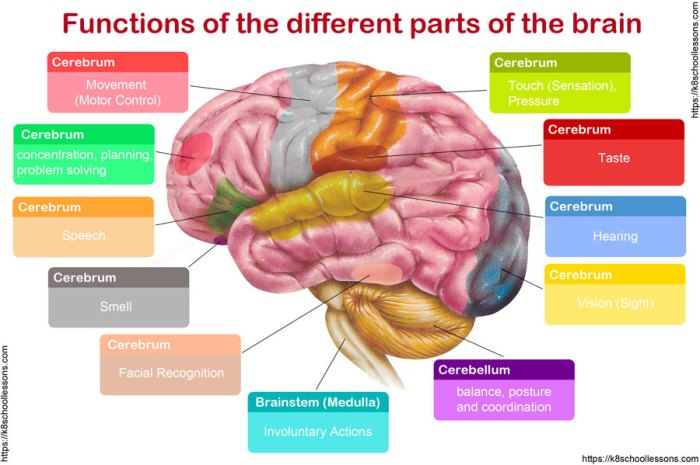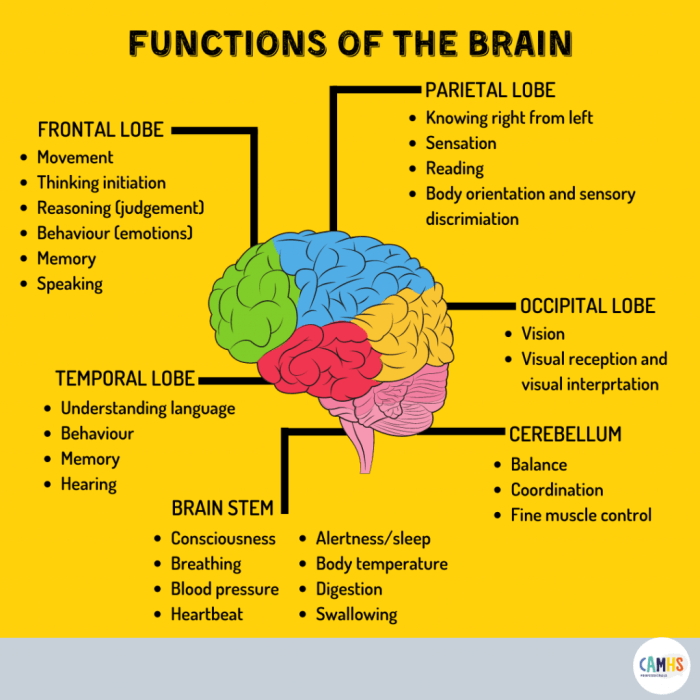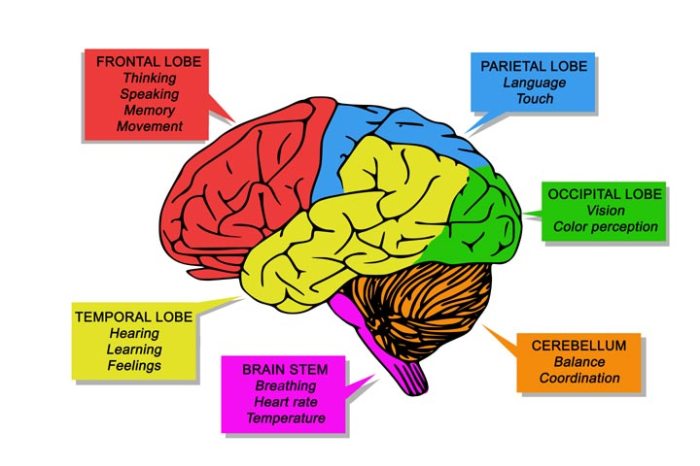Functions of different parts of the brain – Unveiling the Functions of Different Brain Regions: Embark on a journey into the intricate architecture of the human brain, exploring the specialized roles of each region in shaping our thoughts, actions, and experiences.
From the decision-making prowess of the frontal lobe to the visual artistry of the occipital lobe, each brain region plays a unique and indispensable part in our cognitive and physical functioning.
Frontal Lobe
The frontal lobe is the most anterior part of the cerebral cortex and is responsible for higher-order cognitive functions such as decision-making, planning, and problem-solving. It is also involved in personality and behavior, and damage to the frontal lobe can lead to a variety of problems.
The frontal lobe is divided into two hemispheres, the left and right frontal lobes. The left frontal lobe is responsible for language and speech, while the right frontal lobe is responsible for visuospatial processing and attention.
Decision-Making and Higher-Order Cognitive Functions
The frontal lobe is responsible for a variety of higher-order cognitive functions, including:
- Decision-making
- Planning
- Problem-solving
- Reasoning
- Judgment
The frontal lobe is also involved in working memory, which is the ability to hold information in mind for a short period of time. Working memory is essential for a variety of tasks, such as following instructions, solving problems, and learning new information.
Personality and Behavior
The frontal lobe is also involved in personality and behavior. People with damage to the frontal lobe may experience changes in their personality, such as becoming more impulsive or disinhibited. They may also have difficulty controlling their emotions and behavior.
Consequences of Damage to the Frontal Lobe
Damage to the frontal lobe can lead to a variety of problems, including:
- Difficulty making decisions
- Problems with planning and problem-solving
- Memory problems
- Changes in personality and behavior
- Difficulty controlling emotions
The severity of the problems will depend on the extent of the damage to the frontal lobe.
Parietal Lobe

The parietal lobe, located at the top-rear of the brain, plays a crucial role in processing sensory information and our understanding of the body and its surroundings. It receives sensory input from the skin, muscles, and joints, allowing us to perceive touch, temperature, and pain.
The parietal lobe also contributes to our sense of spatial awareness, helping us to navigate our environment and interact with objects effectively.
Sensory Processing
The parietal lobe is responsible for integrating sensory information from different parts of the body, creating a comprehensive representation of our physical state. It allows us to distinguish between different types of touch, such as pressure, vibration, and temperature. The parietal lobe also processes taste sensations, enabling us to perceive the flavors of food and drink.
Spatial Awareness
The parietal lobe is essential for our understanding of spatial relationships. It helps us to determine the location of objects in space, estimate distances, and navigate our surroundings. Damage to the parietal lobe can lead to difficulties with spatial navigation, such as getting lost or disoriented in familiar places.
Temporal Lobe
The temporal lobe, located on the sides of the brain, plays a crucial role in memory, language comprehension, and auditory processing. It consists of several regions, each with specific functions:
Memory
The temporal lobe is involved in the formation, storage, and retrieval of memories. The hippocampus, a key structure within the temporal lobe, is essential for the formation of new memories. It processes sensory information and consolidates it into long-term memories.
The medial temporal lobe, including the hippocampus and amygdala, is particularly important for episodic memory, which involves the recollection of personal experiences.
Language Comprehension, Functions of different parts of the brain
The temporal lobe, particularly the superior temporal gyrus, is responsible for language comprehension. It processes auditory information and extracts meaningful units of speech, allowing us to understand spoken language. The Wernicke’s area, located in the posterior superior temporal gyrus, is crucial for speech comprehension.
Damage to this area can lead to receptive aphasia, where individuals have difficulty understanding spoken language.
Auditory Processing
The temporal lobe is also involved in auditory processing. The primary auditory cortex, located in the transverse temporal gyrus, receives auditory information from the ears and processes it, allowing us to perceive and interpret sounds. Damage to this area can lead to auditory agnosia, where individuals have difficulty recognizing familiar sounds.
Occipital Lobe

The occipital lobe, located at the back of the brain, is responsible for processing visual information. It receives signals from the eyes and interprets them into images that we can see. The occipital lobe is divided into several areas, each of which has a specific function.One of the most important areas of the occipital lobe is the primary visual cortex.
This area is responsible for receiving visual information from the eyes and sending it to other parts of the brain. The primary visual cortex is also responsible for processing the basic features of objects, such as their shape, color, and motion.Another important area of the occipital lobe is the secondary visual cortex.
This area is responsible for processing more complex visual information, such as the recognition of objects and faces. The secondary visual cortex also plays a role in our ability to navigate our environment and to coordinate our eye movements.Damage to the occipital lobe can have a significant impact on visual perception.
People who have damage to the occipital lobe may experience a variety of visual problems, such as:* Blindness
- Loss of peripheral vision
- Difficulty recognizing objects
- Difficulty judging distances
- Difficulty navigating their environment
Cerebellum
The cerebellum, located at the back of the brain beneath the cerebrum, is a crucial structure responsible for coordinating movement, balance, and motor learning. It plays a vital role in ensuring smooth and coordinated movements, allowing us to perform everyday activities with precision and grace.
Role in Coordinating Movement
- The cerebellum receives sensory information from the muscles, joints, and vestibular system (responsible for balance).
- It processes this information to calculate the appropriate motor commands necessary for smooth and coordinated movement.
- The cerebellum sends these commands to the motor cortex, which then transmits them to the muscles, enabling precise and controlled movements.
Role in Balance
- The cerebellum receives signals from the vestibular system, which provides information about head and body position in space.
- It uses this information to maintain balance and posture, ensuring we remain upright and stable.
- The cerebellum also coordinates eye movements with head movements, allowing us to focus our vision while maintaining balance.
Role in Motor Learning
- The cerebellum plays a crucial role in motor learning, the process by which we acquire new motor skills and improve our coordination.
- It compares actual movements with intended movements and provides corrective signals to refine motor commands.
- Through repeated practice, the cerebellum helps us improve the accuracy, smoothness, and efficiency of our movements.
Consequences of Cerebellar Damage
- Damage to the cerebellum can lead to a range of motor impairments, including:
- Ataxia: Difficulty with coordination and balance, resulting in unsteady gait and difficulty performing fine motor skills.
- Dysmetria: Inability to accurately judge the distance or force required for movement, leading to overreaching or undershooting.
- Tremors: Involuntary shaking or trembling of the limbs or head.
Brainstem
The brainstem is the most inferior part of the brain, connecting the cerebrum and cerebellum to the spinal cord. It controls vital functions such as breathing, heart rate, and sleep-wake cycles. The brainstem also integrates information from different parts of the brain and body, allowing for coordinated responses to stimuli.
Vital Functions
The brainstem contains several vital nuclei and structures that control essential bodily functions:
- Respiratory Center:Controls the rate and depth of breathing.
- Cardiovascular Center:Regulates heart rate, blood pressure, and blood flow.
- Sleep-Wake Cycle:Regulates the body’s circadian rhythm and sleep-wake patterns.
Integration of Information
The brainstem receives sensory information from the spinal cord and other parts of the brain. It then integrates this information to coordinate motor responses and maintain homeostasis. For example, when you touch a hot object, the brainstem sends signals to your muscles to withdraw your hand and to your cardiovascular system to increase blood flow to the injured area.
Consequences of Brainstem Damage
Damage to the brainstem can have severe consequences, including:
- Loss of consciousness or coma
- Difficulty breathing or swallowing
- Cardiac arrest
- Paralysis
- Death
Therefore, the brainstem is a vital part of the brain that plays a crucial role in maintaining life and coordinating bodily functions.
Closure

In conclusion, the human brain is a symphony of interconnected regions, each contributing to our multifaceted existence. Understanding the functions of different brain regions provides a profound appreciation for the complexity and wonder of the human mind.
Essential Questionnaire: Functions Of Different Parts Of The Brain
What is the primary function of the frontal lobe?
The frontal lobe is responsible for higher-order cognitive functions such as decision-making, planning, and personality.
How does the parietal lobe contribute to spatial awareness?
The parietal lobe processes sensory information from touch, taste, and spatial cues, helping us understand our body’s position in space.
What is the role of the temporal lobe in language comprehension?
The temporal lobe is involved in processing auditory information and plays a crucial role in language comprehension, memory formation, and emotional regulation.